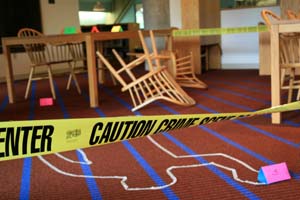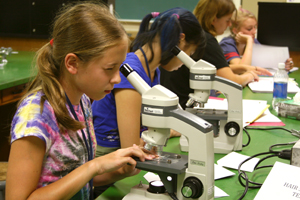This year, Saint Mary's College camps include a CSI-styled "who done it." For five days, campers gather and analyze evidence scientifically to solve a mystery.
Lead investigator Andrea Nicholas ’05 points to the police outline on the third floor of Saint Mary’s Cushwa-Leighton Library. Yellow tape, draped just outside the outline along with overturned chairs and an open notebook on the table, keeps reporters at bay. The victim, said Nicholas, was a brilliant young female student with a predilection for leaving Tootsie Roll Pop wrappers on the floor. When looking for suspects, Investigator Nicholas found plenty of library staffers who admitted they were tired of picking up discarded candy-related debris.
Forensic Science campers study the clues.
At that moment, in the Science Hall, 34 Forensic Science campers, ranging from 8th to 12th graders and grouped into investigative teams, were testing evidence they had retrieved from the crime site in order to solve the crime. “Some of the campers asked really astute questions,” mused Nicholas. “They wondered why the outline was in the form of a man when the victim was a woman.”
Nicholas says that the investigation--or camp—began Monday, July 12, 2010, and continues until Friday afternoon, when each forensic science team will present a case for ‘who dunnit’ by submitting a written report detailing the outcomes of the scientific evidence, interviews with the suspects, and other clues. They also will give a PowerPoint presentation on how they constructed their case for determining the perpetrator.

Crime scene
Along with Nicholas, Saint Mary’s students Alie Bennet '11, a biology major, and Nicole Hartwig '12, a nursing major, are acting as crime lab supervisors.
Friday, July 16, campers appeared on stage at O'Laughlin Auditorium. They enacted the crime in a short play and gave a PowerPoint presentation to describe their work in solving the crime. For example, on a visit to the South Bend Police Department, they heard from real crime investigators how scientific study actually takes place. Campers then went back to the "crime scene" to collect evidence. They also interviewed suspects; tested hair samples, fingerprints, and handwriting samples in the lab, and compared these samples to those of the six suspects'.
Investigator Nicholas said every team came to the same conclusion -- the scientific evidence pointed to Suspect #6, Kitty, a library staffer particularly conscientious about keeping the library neat.
Saint Mary's College's Summer Academy offered the Forensic Science camp for the first year this summer. While Saint Mary’s has held science and mathematic camps for several years, a few Saint Mary’s College science faculty and previous campers pushed for this summer camp to be specific to forensic investigation and science.

